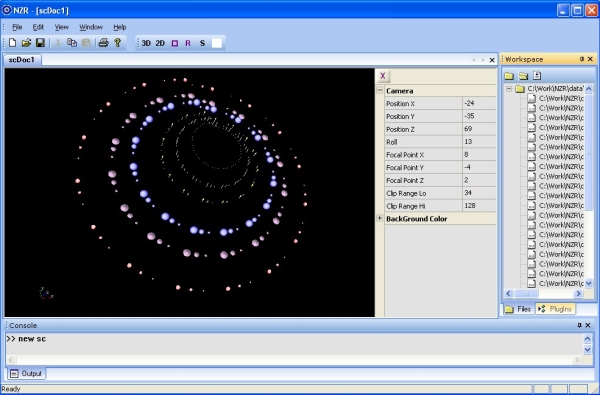

Introduction
If you live in Boston, then going to the Fire & Ice Restaurant is a treat. You can create your own special dish from a wide assortment of ingredients and sauces without having to go through the hassle of preparing the ingredients. NZR Visualization Framework borrows a page from Fire & Ice by offering a developer the ability to tailor visualizations of a wide assortment of data types in a 3D window without having to learn OpenGL or some other complicated visualization library. This tutorial focuses on visualizing point data with NZR and highlights the simplicity of doing so.
Something as innocuous as points can have considerable sophistication when it comes to rendering them in 3D space. Visualizing point data is commonly needed when developing algorithms, scientific data gathering, financial modeling, etc. The developer typically has to either learn a complicated graphics package or rely on canned applications. NZR is a new visualization framework announced by SoftServ Int'l. Corp. that decouples all data-rendering complexity for the developer and offers a very simple API for rendering various types of data. Here I will present visualization of point data using NZR Lite, which implements a subset of NZR features. You are encouraged to try out the different attribute settings to explore the applicability to your needs.
Using the Code
Point visualization consists of the following steps:
- Instantiate the point data structure.
- Call
newObject() to set the default values locally, i.e. in your program. - Modify attributes locally.
- Call
createObject() to instantiate the object in NZR memory. - Populate the point data array.
- Call
writeObject() to transfer the point data to NZR. - Set the camera at the correct 3D position.
- Call
render() to render the data.
NZR has different types of cursors to facilitate viewing the data. The main NZR window has a panel that displays camera settings at any point. These settings can be used to establish the right parameters for programmatically setting the camera.
The first example displays the point data using CONE glyphs that have been scaled based on the intensity associated with each point.
#include "nzrLiteClient.h"
pPointLocations = new nzr_points;
myNZRClient->newObject(pPointLocations);
pPointLocations->cmnd.display.colorR = 10;
pPointLocations->cmnd.display.colorG = 10;
pPointLocations->cmnd.display.colorB = 10;
pPointLocations->glyphType = CONE;
pPointLocations->glyphScale = (float) 0.05;
pPointLocations->glyphScaleMode = INTENSITY;
myNZRClient->createObject(pPointLocations);
float alpha = 20.0;
float beta = (float) 0.02;
pPointLocations->sizeOfData=0;
for( int t = 0; t < NUMBER_OF_POINTS; t++)
{
inputArray[t].x = (float) alpha*sin(t/(float) 10.0);
inputArray[t].y = (float) alpha*cos(t/(float) 10.0);
inputArray[t].z = (float) beta*t; inputArray[t].intensity = (float) (t%10); inputArray[t].vx = 0;
inputArray[t].vy = 0;
inputArray[t].vz = 1.0; pPointLocations->sizeOfData++;
}
myNZRClient->writeObject(pPointLocations, (void *) &inputArray[0]);
pMyCamera = new nzr_camera;
myNZRClient->newObject(pMyCamera);
pMyCamera->FocalPointX = 0;
pMyCamera->FocalPointY = 0;
pMyCamera->FocalPointZ = 0;
pMyCamera->posX = 0;
pMyCamera->posY = 0;
pMyCamera->posZ = 100;
pMyCamera->ClippingNear = 97;
pMyCamera->ClippingFar = 103;
myNZRClient->setCamera(pMyCamera);
myNZRClient->render();
Link the program with nzrLiteClientLibR.lib. That is all. NZR Lite should be running with sc doc opened before running the example. There are a couple of helper functions available to delete either individual objects or all objects in the scene. Background color can also be programmatically set.
At times, there is a need to represent vector data associated with a point, e.g. visualizing the dynamics of a golf swing. The second example shows how this can be done and additional point data presented with a second set of points, but visualized with a different glyph type. Here vector data is being visualized by enabling glyphScaleMode to VECTOR and populating the vector data as shown below.
pPointVectors->glyphScaleMode = VECTOR;
pPointVectors->glyphType = ARROW;
...
for( int t = 0; t < NUMBER_OF_POINTS; t++)
{
...
inputArray[t].vx = (float) 12*sin((float)t/20.0); inputArray[t].vy = (float) 12*cos((float)t/20.0); inputArray[t].vz = (float) 0; }
Complex point data can employ a similar strategy of using a combination of color, glyph type, scale mode and opacity to visually convey sophisticated data values.
Points of Interest
I have also included rendering polylines in the library that you could experiment with. I will cover visualizing lines with NZR at some later time.
History
- August 2007: Initial release
